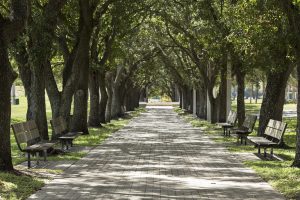We’ve all heard the old saying, “money doesn’t grow on trees.” While that is technically correct, research shows that there are many benefits of urban forestry, including saving money. Trees reduce and treat stormwater at its source while delivering many environmental, social, and economic benefits.

Benefits of Urban Forestry
Osceola County is rapidly growing. In the past 5 years, population growth has exceeded 25%, and by 2030 the county is estimated to be home to over half a million people. This increasing urbanization puts a strain on the county’s natural resources, such as water. As the county grows, more land will be developed, which creates a higher proportion of impervious surfaces. Impervious surfaces are artificial structures such as roads, parking lots, sidewalks, and any other paved areas. Unfortunately, they do not allow rain water to infiltrate into the ground. One solution? Trees.
Trees have many benefits. They:
- Reduce stormwater runoff and pollutants
- Act as a natural air purifying system
- Cool houses and buildings
- Provide food and shelter for other animals
- Bring beauty and recreation to communities
Right Tree, Right Place
The urban forest is made up of trees and other vegetation within the built environment. It includes all the trees in an urban area including street trees, private homes, and parks, but can also refer to a centralized forest in the city. While there are many benefits of urban forestry, it is important to understand the costs such as maintenance and potential building damage. These costs can be minimized by selecting the right tree for the right place. Proper management and care can further increase benefits and decrease costs, making urban forests a good investment. Experts estimate that trees can provide a $1.50 to $3 rate of return for every dollar invested. This means that their benefits more than make up for the cost of planting and maintenance. I’d say that’s a tree-mendous investment.
More information on urban forestry
 0
0
